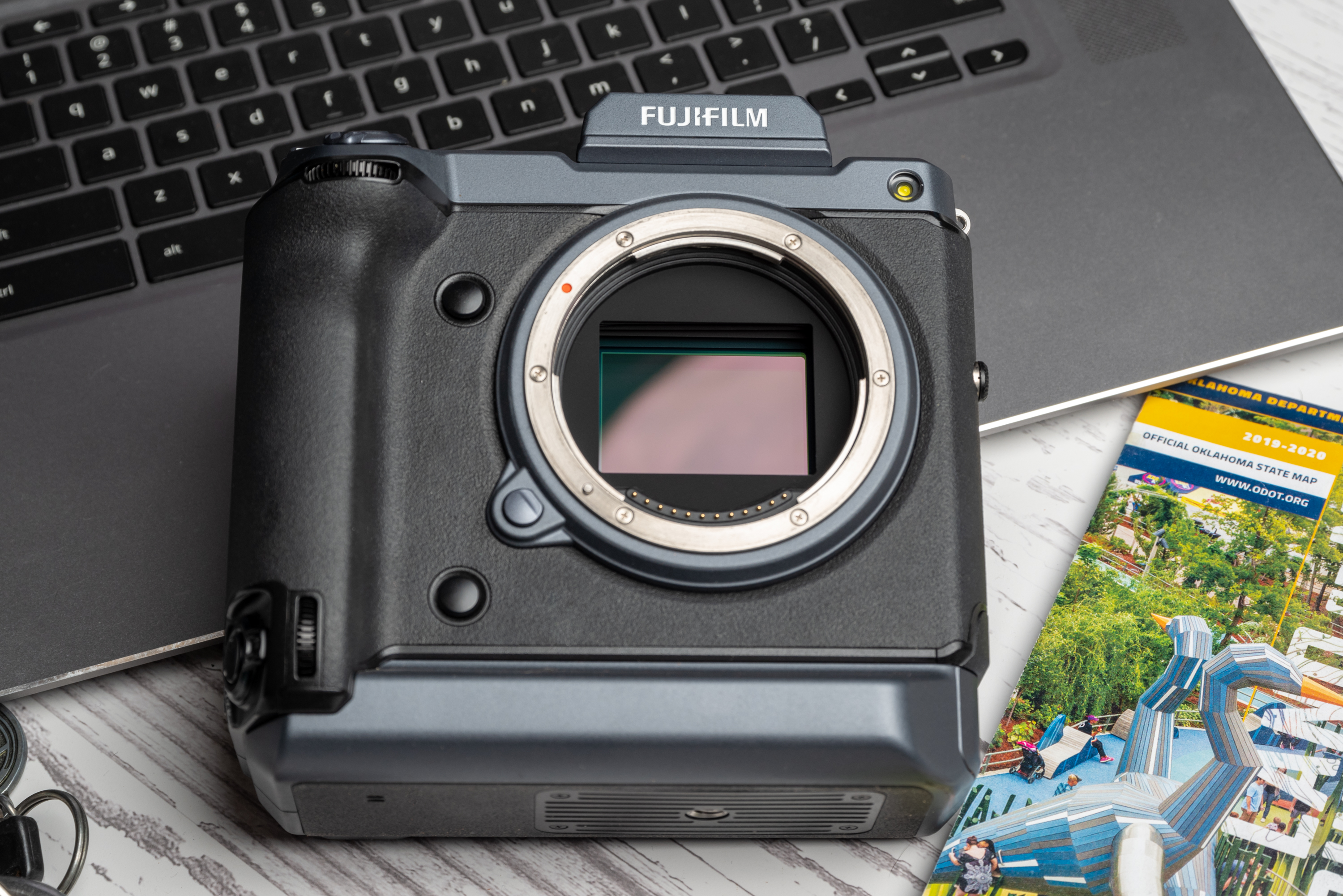Last Updated on 02/04/2020 by Brett Day
The sheer power of the Fujifilm GFX 100 and its price point is enough to turn the heads of many, but some issues show there’s more to a camera than its sensor.
Fujifilm shocked the world when they announced the Fujifilm GFX 100. The GFX 100 follows the already impressive GFX 50S and the GFX 50R. There’s already a solid line-up of glass for the platform, so the GFX 100 can hit the ground running. Somehow, Fujifilm has made a camera that breaches the 100 Megapixel mark. Priced at $9,999, surely, there has to be a catch! So what do we have with the Fujifilm GFX 100? Well, we have one heck of a sensor. This sensor is paired with one of the most impressive AF systems we have used in recent memory, and it has IBIS. Fujifilm says that the GFX 100 is revolutionary because, for the first time, a Medium Format camera can be used outside a studio setting and off of a tripod, while still recording insanely detailed images. Can the Fujifilm GFX 100 live up to the hype?
On paper, it looks like the Fujifilm GFX 100 will be able to be used comfortably by wedding photographers and event photographers who don’t want to be tied to a tripod, and even by street and lifestyle photographers thanks to the AF and IBIS system. But is this the case? We used the Fujifilm GFX 100 for a couple of weeks, and got to know it very well. Let’s take a closer look at this beast.
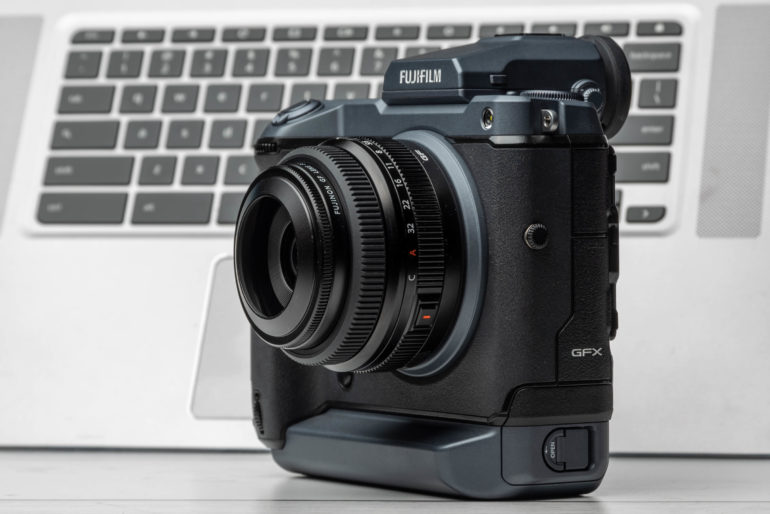
Pros and Cons
Pros
- 102 amazing Megapixels
- Under $10,000 for one of the most powerful Medium Format cameras on the market
- It uses the same autofocus system as the X-T3
- A gorgeous electronic viewfinder
- The menu system is perhaps only second to Canon’s in terms of design
- The image quality is simply jaw-dropping
- Fantastic high ISO capabilities
- Very good battery life
- The top and rear LCD and OLED panels are easy to see and read in bright conditions
Cons
- Quite possibly the worst ergonomics of any camera I’ve used
- The thumb rest on the back is poorly designed
- The body of the Fujifilm GFX 100 feels incredibly cheap
- The buttons are mushy and have hardly any tactile feel
- AF tracking was hit or miss, as was the eye AF
- The touchscreen cannot be used to navigate the menu system
- The grip is too shallow and does not provide a comfortable way to hold this 3lb camera
- The vertical grip is untextured and incredibly slippery
Gear Used
We used the Fujifilm GFX 100 with the GF100-200mm f5.6 RLM OIS WR, the GF63mm f2.8 R WR, and a pre-production model of the GF50mm F3.5 R LM WR.
Tech Specs
We have listed the most important technical specifications for the Fujifilm GFX 100. For all specifications, head on over to the official Fujifilm website.
Number of effective pixels – 102 million pixels
Image sensor – 43.8mm x 32.9mm Bayer array with a primary color filter
Storage media – SD Card (-2GB) / SDHC Card (-32GB) / SDXC Card (-512GB) UHS-I / UHS-II / Video Speed Class V90*1
Lens mount – FUJIFILM G mount
Sensitivity – Standard Output Sensitivity AUTO1/AUTO2/AUTO3 (up to ISO12800) / ISO100-12800 (1/3 step) , (Movie: AUTO / ISO200-12800), extended output sensitivity, ISO50 / 25600 / 51200 / 102400, (Movie: ISO25600)
Image Stabilizer – shift mechanism with 5-axis compensation, compensation effect 5.5 stops (based on CIPA standard). Pitch/yaw shake only. With GF63mmF2.8 R WR lens mounted.
Continuous shooting – CH approx. 5.0fps (JPEG: 41 Frames Lossless compression RAW: 14 Frames Uncompressed RAW: 13 Frames), CL approx. 2.0fps, (JPEG: Endless Lossless compression RAW: 20 Frames Uncompressed RAW: 15 Frames)
Viewfinder – 0.5 inch Approx. 5.76 million dots OLED Color Viewfinder, Coverage of viewing area vs. capturing area: Approx. 100%
LCD monitor – 3.2 inches, Aspect Ratio 4:3, Approx. 2.36 million dots Tilt-Type(Three Direction), Touch Screen
Sub LCD monitor – 1.80 inches, Aspect Ratio 4:3, 303×230-dot Monochrome LCD Monitor
Rear sub monitor – 2.05 inch, Aspect Ratio 4:1, 256×64-dot Monochrome OLED Monitor
Battery life for still images – approx 800 frames
Weight – 1,400g / 49.4oz. (including EVF, battery x2 and memory card)
Autofocus Points – 425
Other Specs – 16 Fujifilm simulations, Wi-Fi, Bluetooth, 4K video 29.97p / 25p / 24p / 23.98p 400Mbps/200Mbps/100Mbps up to Approx. 60min, USB Type-C, HDMI Micro connector (Type D), operating temperature -10°C – +40°C (+14°F – +104°F), operating humidity 10 – 80% (no condensation).
Ergonomics
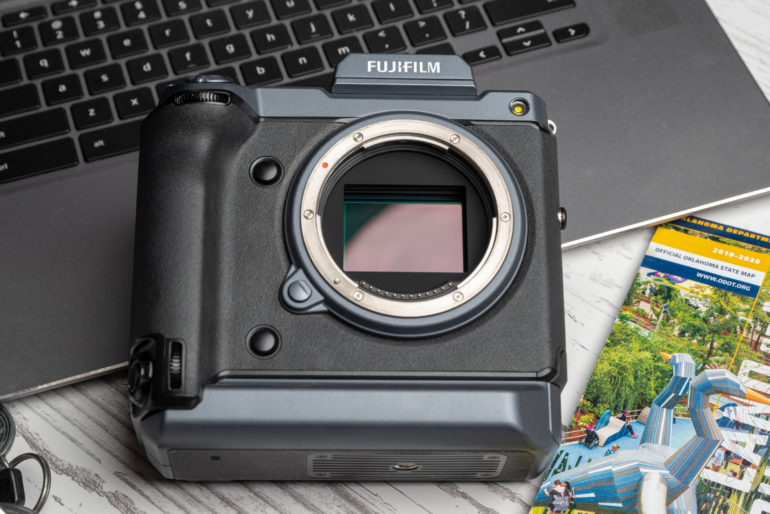
Fujifilm definitely wasn’t going for any design awards when they created the body to surround the heart of this camera. Here you can see the large GF mount with the huge 102 Megapixel sensor in the center of the camera. To the top left you can see the front control wheel, on the bottom left is the control wheel and shutter button for the vertical grip, and on the left side of the mount you can see the lens release and two customizable function buttons. You can also see the main grip and the vertical grip here. Unfortunately, the main grip is very shallow, which makes the Fujifilm GFX 100 difficult to handhold for long periods.
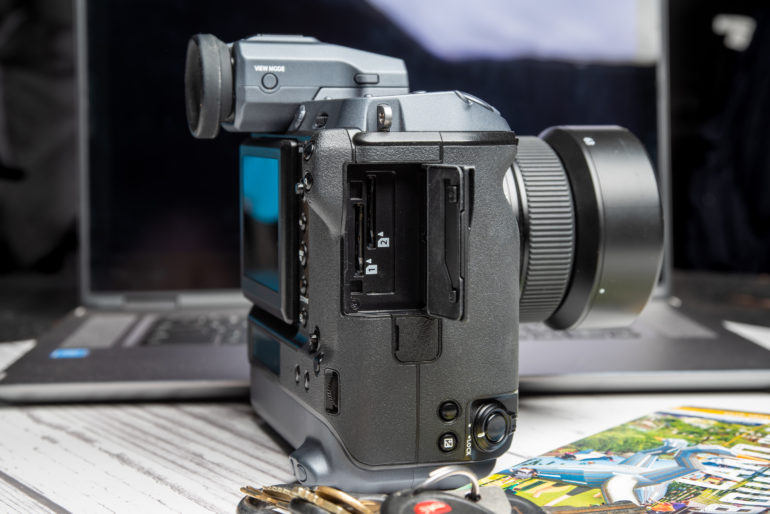
On the right-hand side of the camera, you’ll find the nicely weather-sealed door for the two card slots, and beneath it is the remote release connector. At the very bottom, you can see the controls for the vertical grip. To the top left of the card slot cover, you will see the thumb rest which became one of the biggest pains during the review period.
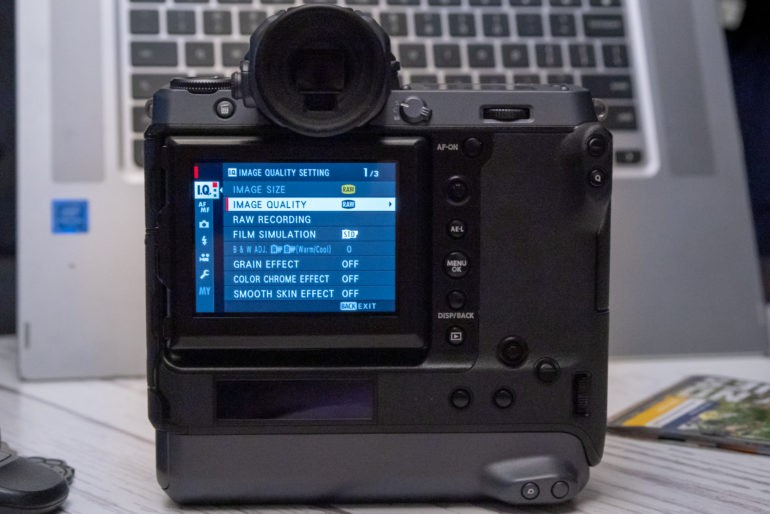
The backside of the camera is dominated by the 3.2-inch tilting (not fully rotating) display which boasts 2.36 million dots. Directly beneath it is a secondary OLED display which can show your exposure meter, basic settings, or the histogram. On the right-hand side of the screen is the primary thumb control stick, the AE-L button, the menu button, and the playback button. Flanking the eyepiece, you’ll find the delete button, and the control for single shot, continuous, or manual focus. The dial controlling shutter speed is on the top right, and the Q button for the control overview page is on the thumb rest. There is a lot of wasted real estate before you get down to the secondary thumb joystick for when you’re in vertical mode.
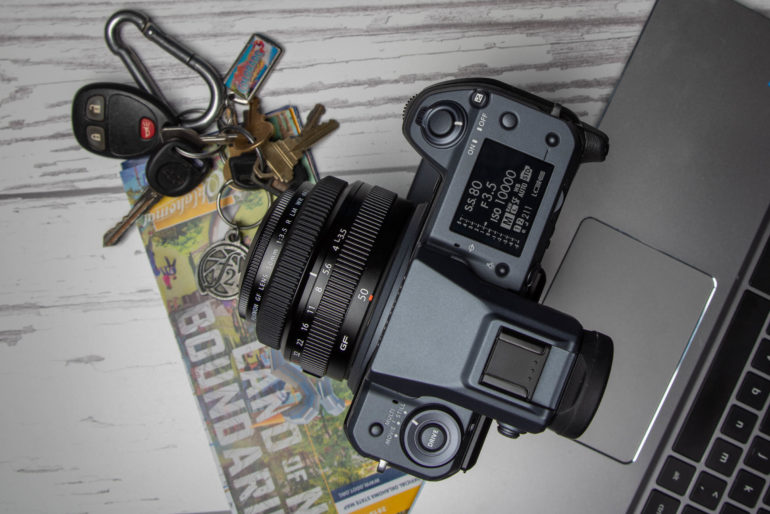
The top of the GFX 100 is the most beautiful looking section of the entire camera. To the left is the drive wheel which you turn to select stills, multi, or movie modes. The button in the middle of the wheel will bring up a screen where you can select single shot, continuous low, or continuous high burst modes. The large eyepiece sits just left of center, and then you’ll find the LCD that displays all of your primary settings. You can either have the view that I had selected here, or it can show two wheels which look like the physical controls on the X-T3.
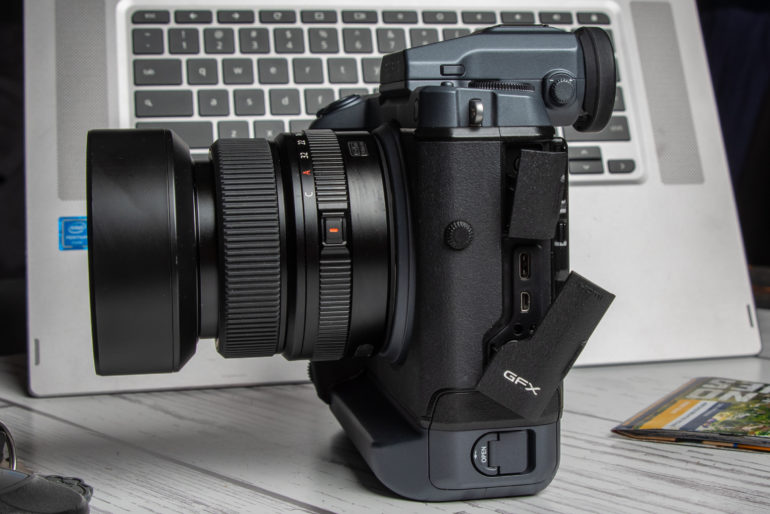
The left-hand side of the camera will greet you with two flaps that cover the USB-C port, the Micro HDMI port, microphone, and headphone jacks, and a DC connector for external power. Underneath the connection covers, you can see the battery tray. You can also see the untextured, slippery vertical grip at the bottom of the camera here. Overall, the GFX 100 is a pretty unremarkable camera when it comes to design. It’s rather bland, but it’s quite functional.
Build Quality
“The plastic feels (to be blunt) of toy-like quality. Tap on the plastic, and it sounds hollow; a drop test is something you do not want to do with this camera.”
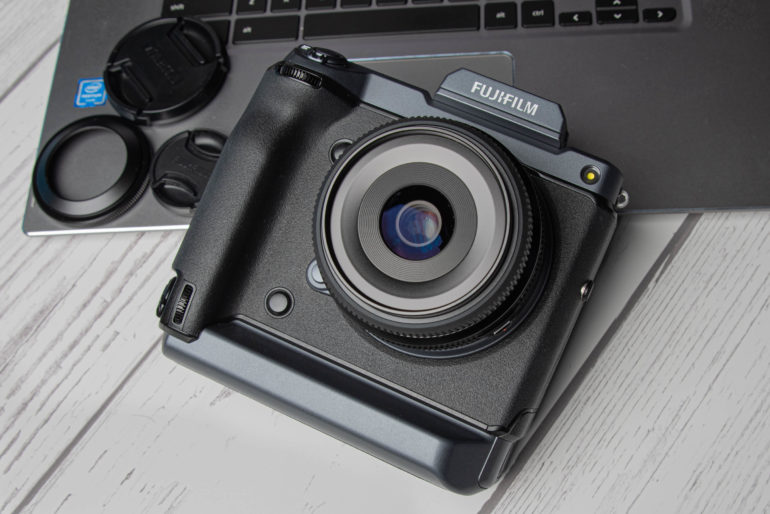
The build quality is an area where I have complaints. The Fujifilm GFX 100 is weather-sealed, and it can operate in temperatures as low as +14°F and as high as 104°F. We know the GFX 50R can withstand a solid soaking, and with that in mind we say that the GFX 100 should be okay when used in the rain, but given that the build quality is not the best on the GFX 100 I opted out of putting the GFX 100 through our standard rain tests.
The Fujifilm GFX 100 feels cheap; it certainly doesn’t feel like you’re holding a $9,999.95 camera. The plastic feels (to be blunt) of toy-like quality. Tap on the plastic, and it sounds hollow; a drop test is something you do not want to do with this camera. The dials feel rough, and there’s almost no tactile feedback from many of the buttons. For example, many times I was pushing the thumbstick up and I couldn’t feel anything; I had to keep looking at it to see if it was actually moving. The buttons feel mushy and of poor quality.
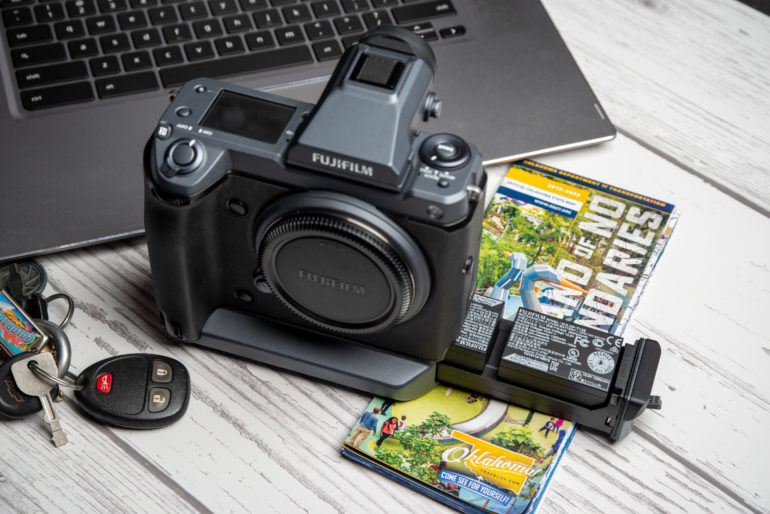
The flaps that cover the connection ports are flimsy and not substantial at all. They remind me of the flaps on older Sony Mirrorless cameras. They are attached to the body with what looks like rubber cord: I don’t think it would take much to accidentally break one off of the body. The texture of the grip is excellent, and it offers a fair amount of resistance, which is great because this is a heavy camera. The eyepiece is excellent and comfortable to use, but it protrudes so much that it can be challenging to see the LCD screen when it is tilted away from the body. You almost have to use the pivoting adapter for the eye-piece (which was not sent for me to test). The hinges for the tilting screen do feel nice and secure though, and the battery tray has a nice snug fit inside the body, so those are pluses. But honestly, everything else about the build is just meh. It’s disappointing, especially as their other cameras (like the X-T3) have such amazing fit and finishes.
Quick Note: After we finished writing our review, Fujifilm released a service advisory in regards to issues surrounding the build quality of the Fujifilm GFX 100. It appears that some units have experienced issues with the locking switch that controls the shutter button on the vertical grip. While we did not experience this issue during our time with the GFX 100 review unit, it does go hand-in-hand with our general feelings about the camera’s overall build quality.
Ease of Use

Overall the Fujifilm GFX100 is easy to use. If you have used any of the XT series of cameras, you’ll feel right at home here. The Menu system is nicely laid out, easy to navigate, and in a logical order. Within a few minutes, you’ll have this camera figured out, and you’ll be breezing through the menus with ease. Unfortunately, the menu system cannot be navigated via touch; you have to use the thumbstick.
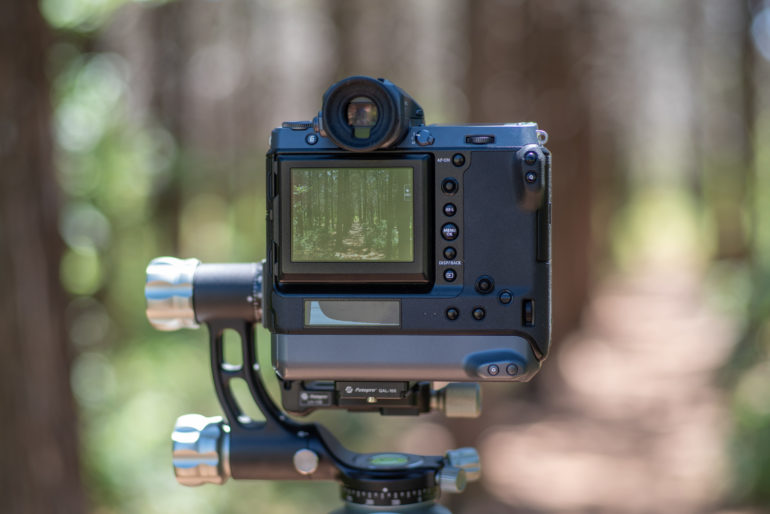
All three of the screens are easy to see and read in full sunlight. This makes the camera effortless to operate. The secondary screen on the back is a genius piece of design. I love that you can configure it to show various information. For me, having the histogram displayed there instead of on the main screen is excellent as it saves valuable space on the main LCD. You can, of course, use the touchscreen to focus, trip the shutter, and pan and zoom in on your photos in playback mode.
The 5.76 million dot EVF is a pure joy to use: it’s easily the nicest looking EVF my eyes have laid their eyes on. Despite all of the screens, the IBIS, and what is going on under the hood, the battery life is good too, with two batteries providing enough juice for about 750 to 800 shots. The Fujifilm GFX 100 is just as easy to use as any modern Mirrorless camera. There is no need to feel intimidated by this camera. Yes, it’s big and powerful, but it feels no different than using a Fujifilm X-T3.
Handling
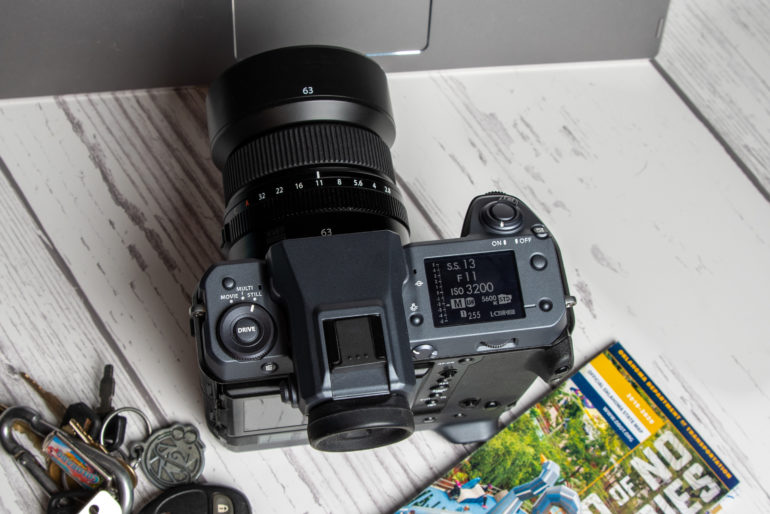
Fujifilm has said the GFX 100 is the first Medium Format camera that can be used for multiple genres outside of a studio, and sans tripod due to its AF system and the performance of the in-body image stabilization. While this is true to an extent, you’re not going to want to use this camera for long periods without having a tripod nearby.
To see if the Fujifilm GFX 100 could be used handheld for hours on end (like an event or wedding photographer would use it), I took the camera out for a photo walk that lasted about four hours. That’s the average time of an event, and nearly half as long as a wedding day shoot. It was agony.
The grip on the GFX 100 is very shallow for a camera of this size and weight, which makes it hard to grip. You’ll find yourself holding the camera in such a way that it causes pain and cramping. The thumb rest on the back of the camera will become your worst enemy. The thumb rest is textured, but it is unpadded and it will potentially rub the skin off your thumb and cause blisters. The vertical grip is genuinely horrible. It is unpadded, has no texture, has sharp edges, and is slippery. It does not instill confidence in the person holding a ten thousand dollar camera. This may be a Medium Format camera that can be used handheld outside of a studio, but that doesn’t necessarily mean that it should be, unless you’re a masochist.
IBIS
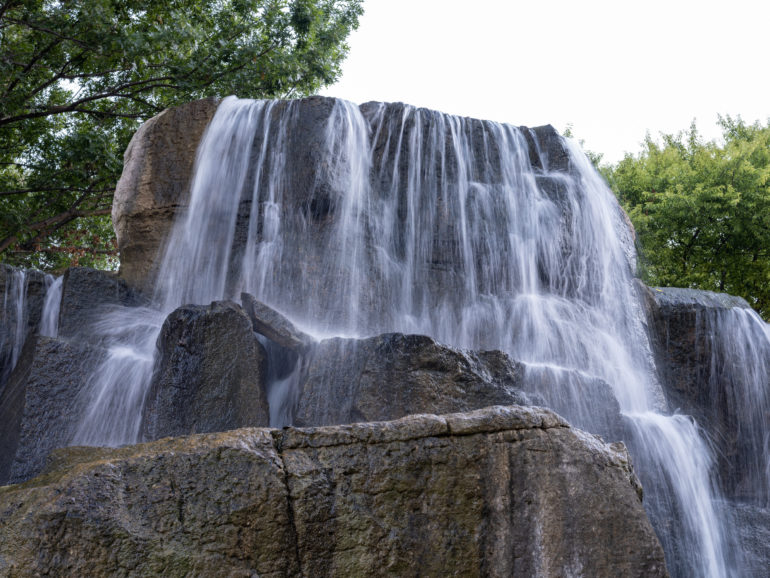
The IBIS in the Fujifilm GFX 100 is fantastic. When tested, I found that it could be used with a shutter speed of 1/10th of a second. Even at these slow shutter speeds, you will still get very sharp, incredibly detailed images if you have good technique. The IBIS system is one of the reasons why this camera can be used without a tripod. It’s seriously impressive. The IBIS is good for 5.5 stops, so low light shooting is a breeze as well. This is definitely one of the revolutionary features in this Medium Format camera.
Autofocus
The Fujifilm GFX 100 borrows the same AF system that can be found in the X-T3. For the most part, the AF system performs well. As you can imagine, it’s not as fast as it is in the X-T3, but in terms of Medium Format, the GFX 100 is lightning fast. However, there are some issues. Use the AF system in single-shot, and you’ll never miss: it’s that good. But switch to continuous focus and enable tracking and the performance leaves a little to be desired.
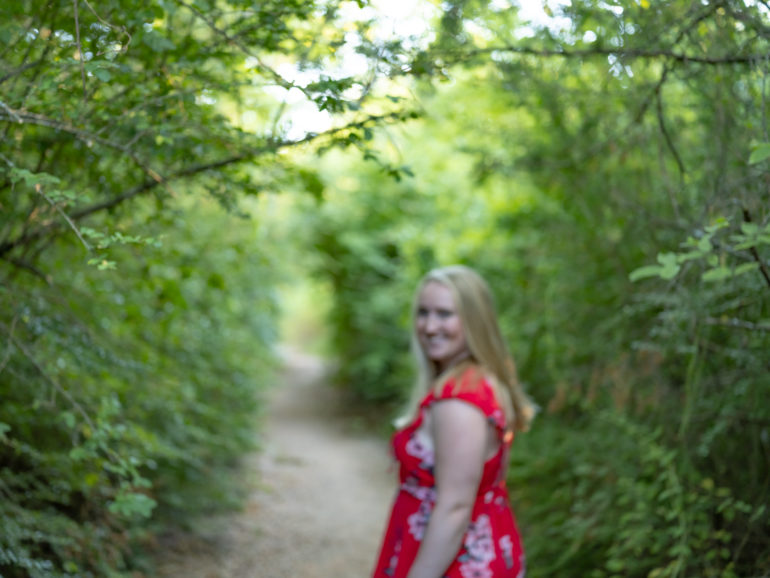
There were quite a few occasions during my time with the GFX 100 where the camera simply could not focus on a slow-moving subject. The image above is an example. I had my model walk away from the camera and had her turn slowly towards me before I took the shot, and this was the result about six out of ten times. The fact that the keeper rate for a Medium Format camera is about 40% with moving subjects is impressive, and it shows that Fujifilm is on the right track. But don’t expect miracles. Fujifilm is getting there, but there’s a lot of room for improvement.
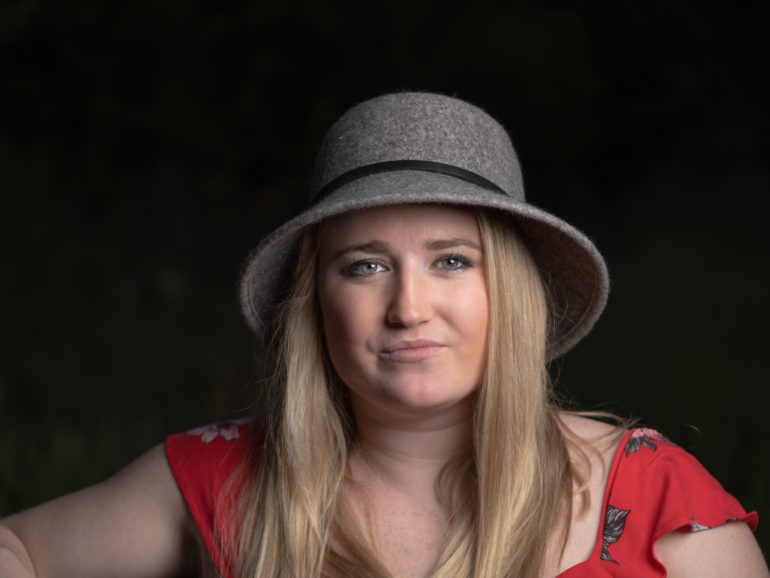
The eye AF suffered the same fate as the tracking system. I had a hard time getting the camera to find my subjects eyes at times, even when my model (Ashlyn Paulson) was stationary. The success rate of getting the eye AF to see the eye was about five out of every ten deliberate attempts to get it to engage. I’m sure the algorithms will be updated with future firmware updates, but this feature should be performing better out of the box.
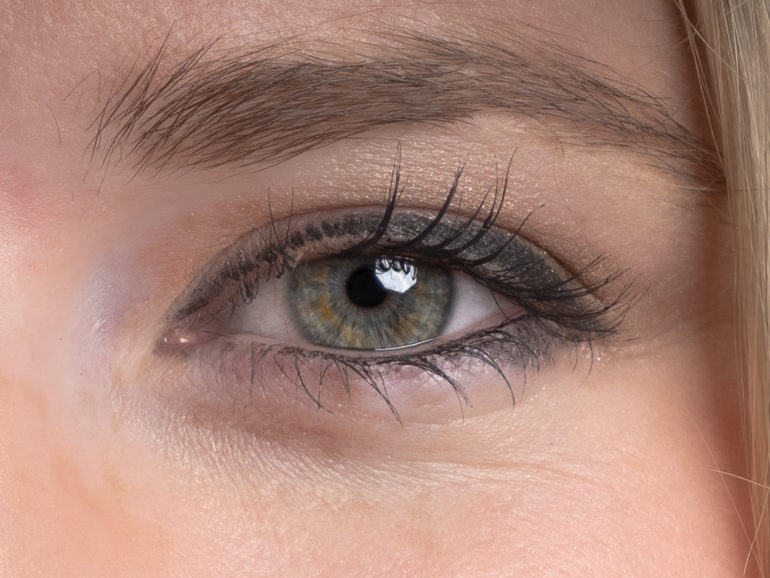
Take the shot when eye AF is locked on though, and be prepared to be amazed. The image above is a crop of the portrait directly above it. The eye AF, when coupled with the power of the 102 Megapixel sensor, will make you weak at the knees, But it’s incredibly frustrating waiting for it to find the eye in the first place. Overall, the systems that the camera employs (when they work), the menu system, the delightful main touchscreen, the additional screens, and the EVF make the GFX 100 nice to use.
Image Quality
When the Fujifilm GFX 100’s 102 Megapixel backside illuminated sensor, all of its AF systems, and its IBIS are working in perfect harmony, wow! I just don’t know what else to say. Looking at the images captured here does not do them justice. Sure they look good, but what you don’t get to see is the amount of detail. You can crop, and zoom, and crop some more and you’ll not lose any detail or image quality. You can essentially get multiple images from the original composition. The output from this camera is simply mind-boggling.


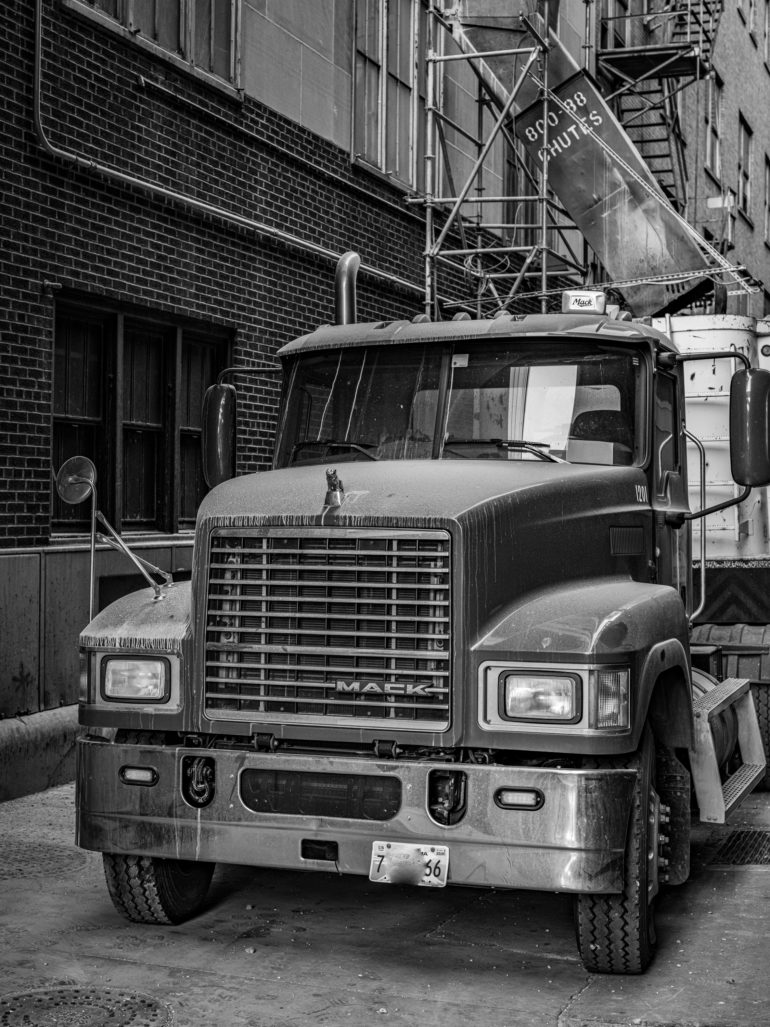

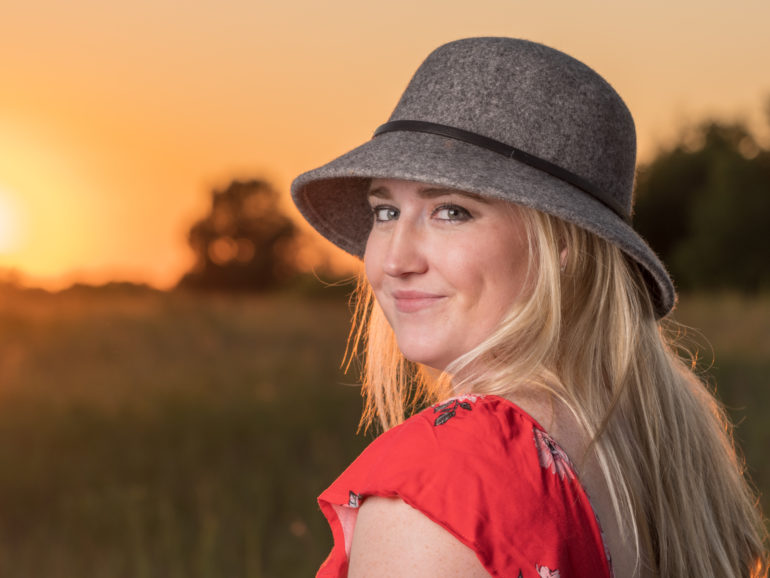
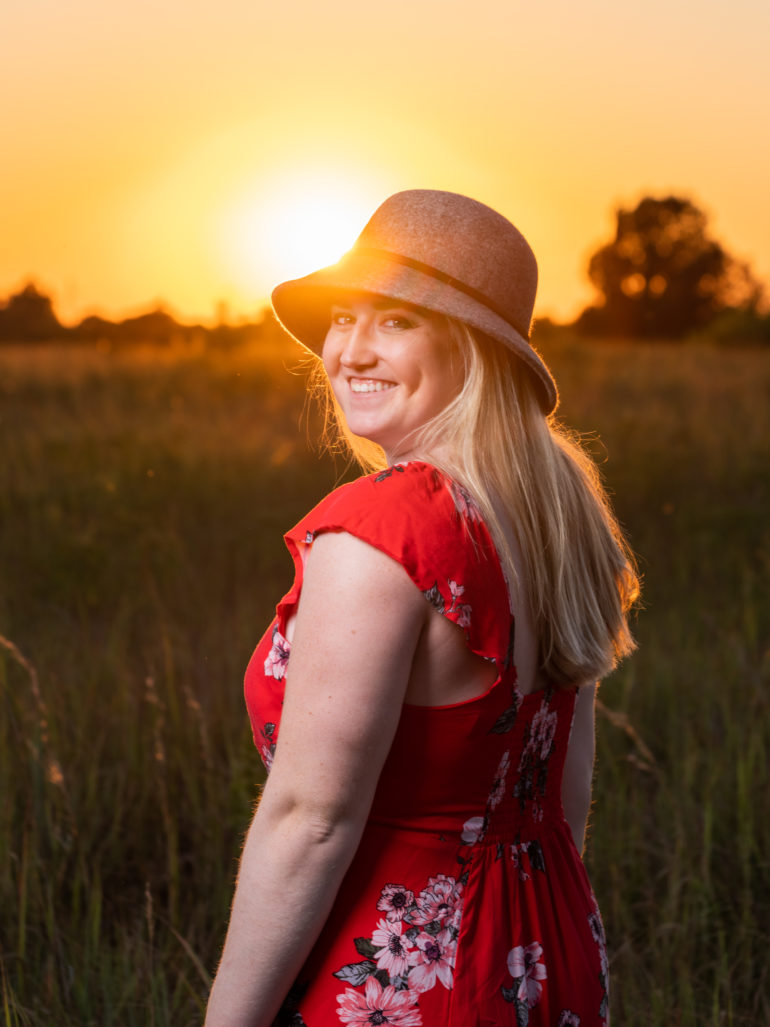
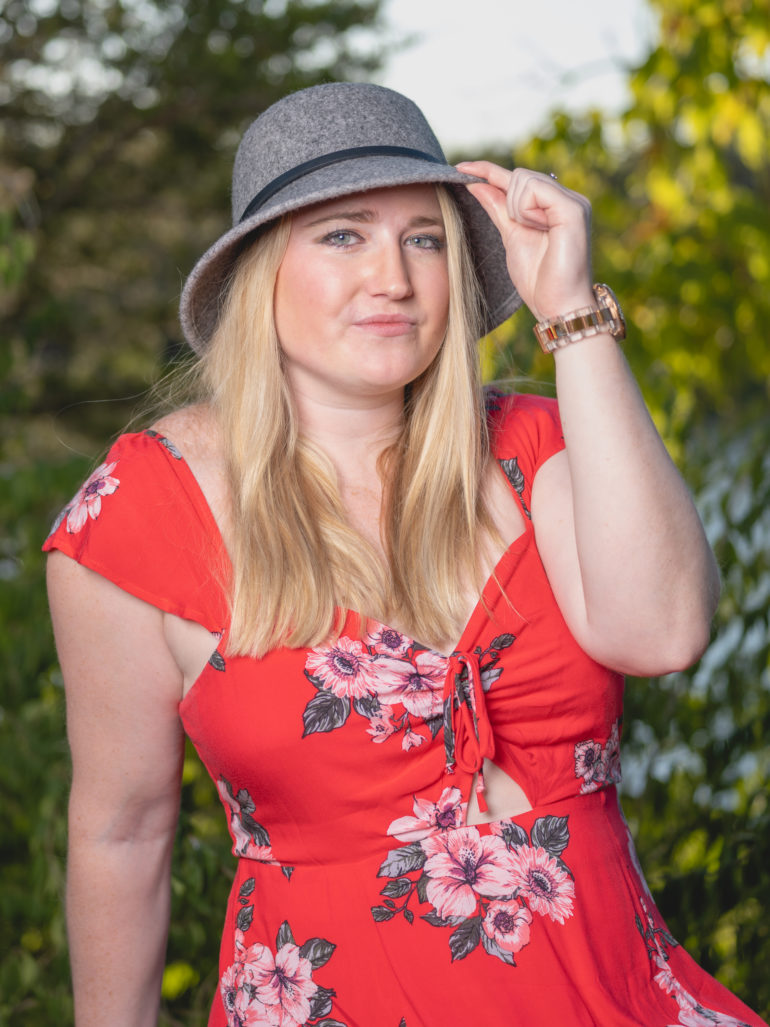


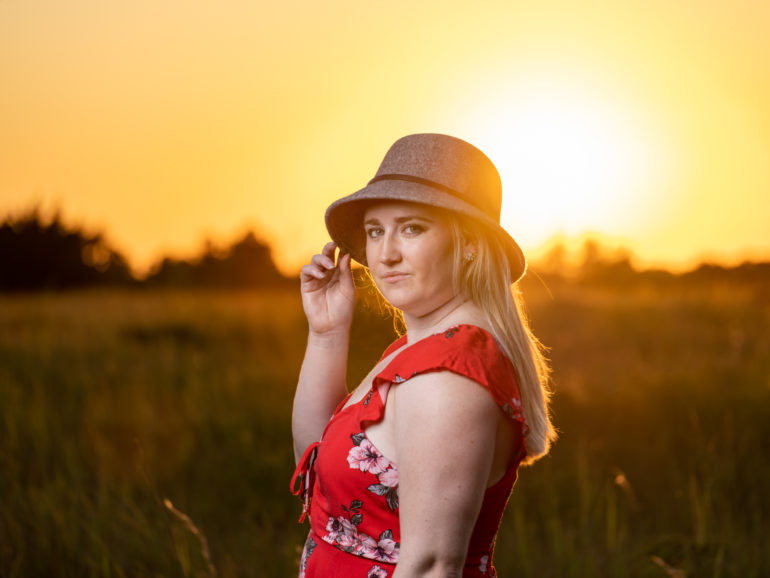
Raw File Versatility
The RAW files are a delight to work with. You can push and pull them as much as you wish, and you’ll always be able to get the image to look exactly how you want it to. If you seriously mess up your exposure, don’t sweat it; you’ll be able to fix it during post, guaranteed. Here’s an image I underexposed on purpose to test out the dynamic range.
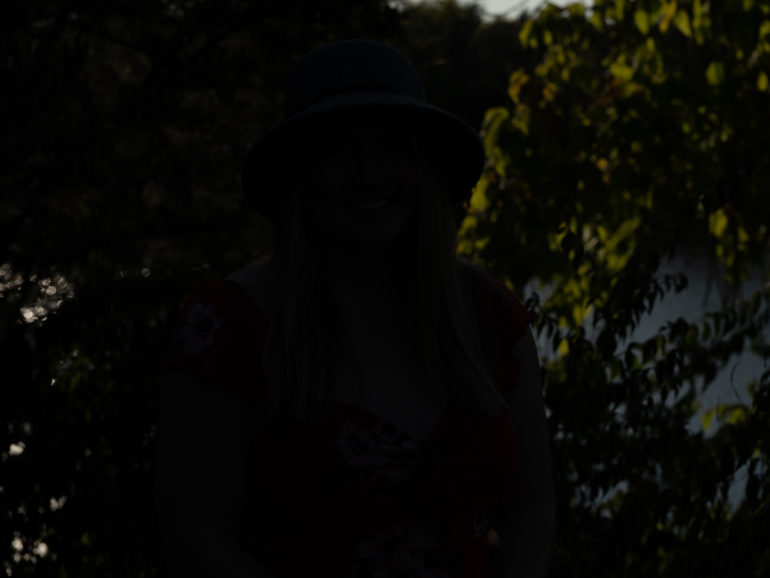

This is the result after playing with the RAW file in post. The shadow recovery is insane. This works the other way too. Blow out your highlights, and you’ll be able to recover them also. The RAW files come in between 202-205MB each which are huge, but just look at what you can do with them! Pack some extra SD Cards: you’re going to need them.
A 64GB card will hold roughly 250 images. Be mindful of this if you shoot in burst mode. Make sure you use UHS-II cards because it takes a while for the files to write to the card. JPEGS are equally as impressive. The camera renders gorgeous JPEG files, and they weigh in at around 28MB each. Don’t forget that the GFX 100 comes with the 16 Fujifilm film simulations that we have come to love, and they look better than ever.
High ISO Output

When it comes to high ISO, you’ve really got very little to worry about. The native ISO range for the GFX 100 is 100-12,800, with extended ranges from 50 – 102,400. From ISO 100 – 1000, images look virtually identical. From ISO 1000 – 3200, you’ll start to see some noise in your pictures, but it’s so subtle you won’t bat an eyelid. From 3200 – 6400, there’s another bump in noise, but again its nothing to write home about.

At ISO 6400 and up there’s another bump, but look, don’t sweat it. You can shoot with this camera from 6400 and beyond, and you’ll get images you can use and print at large sizes. The high ISO performance is another win for the GFX 100. In fact, we printed an image at ISO 6400 on the Canon Prograf-1000 with Canon Pro Luster Paper sized at 17 inches by 22 inches. The result? At ISO 6400, the Fujifilm GFX 100 produces images where there is very tight grain in the images, but that’s only visible when you get very close up. If you didn’t know any better, you’d just think that it was how the print is supposed to come out. Indeed, this is by far the best result that we’ve seen for an ISO 6400 print.
Extra Image Samples



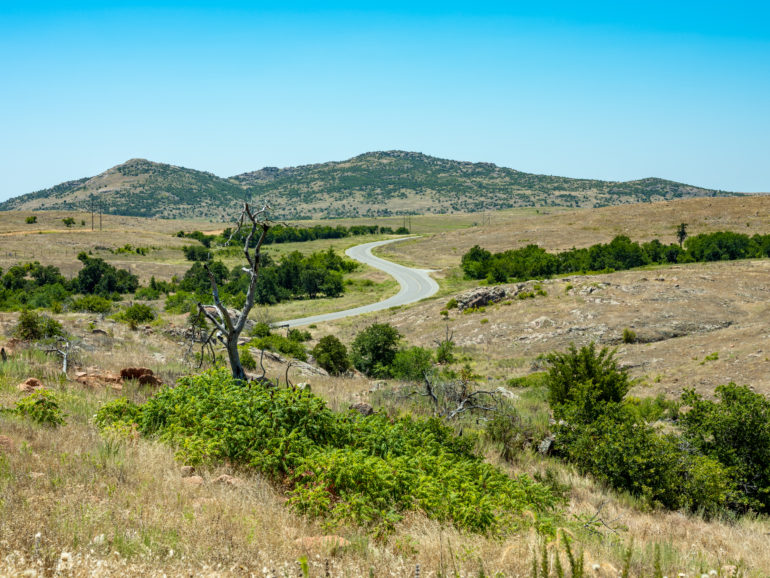

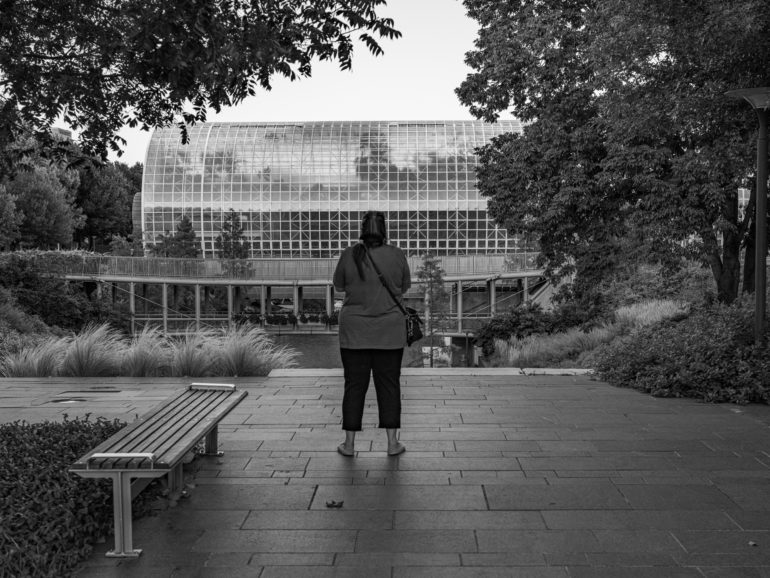
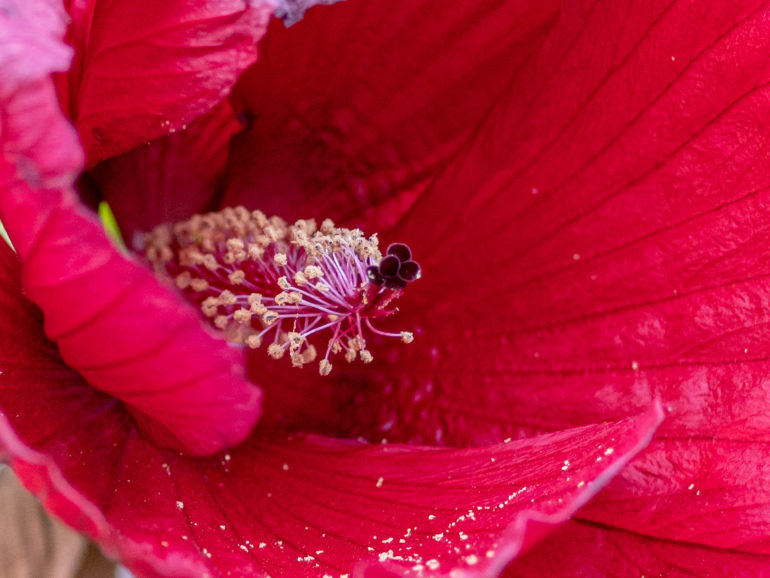
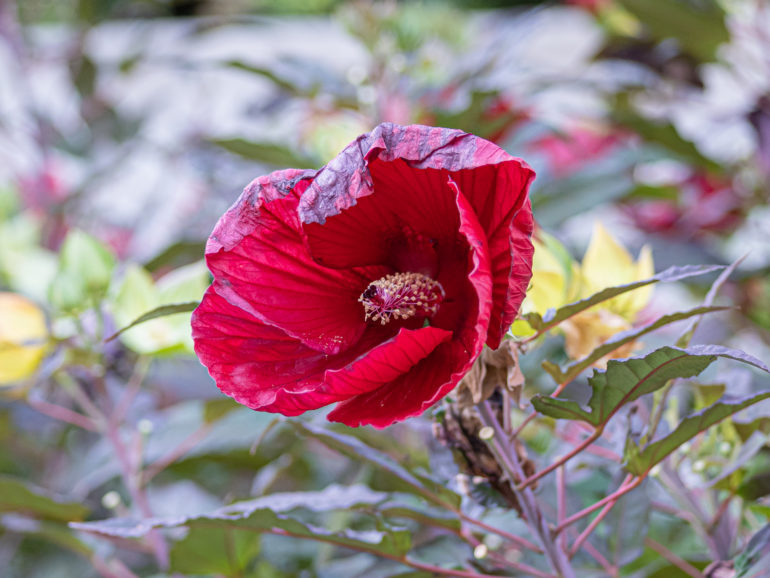
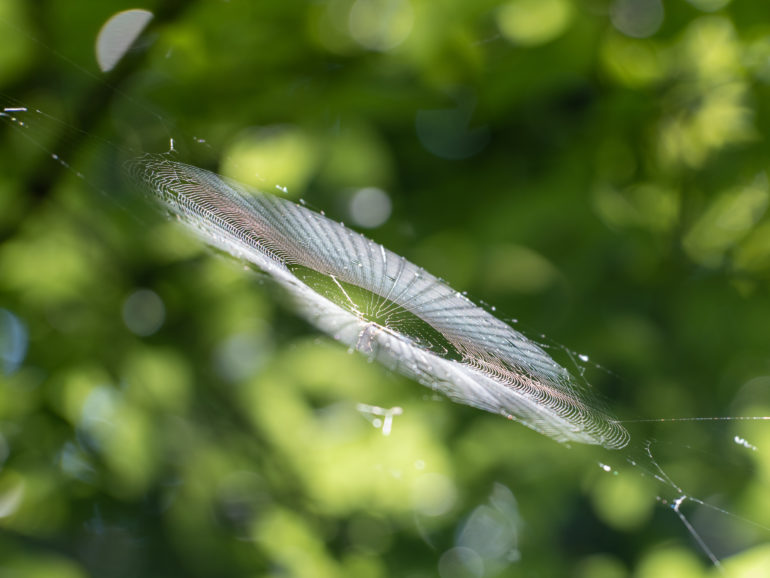




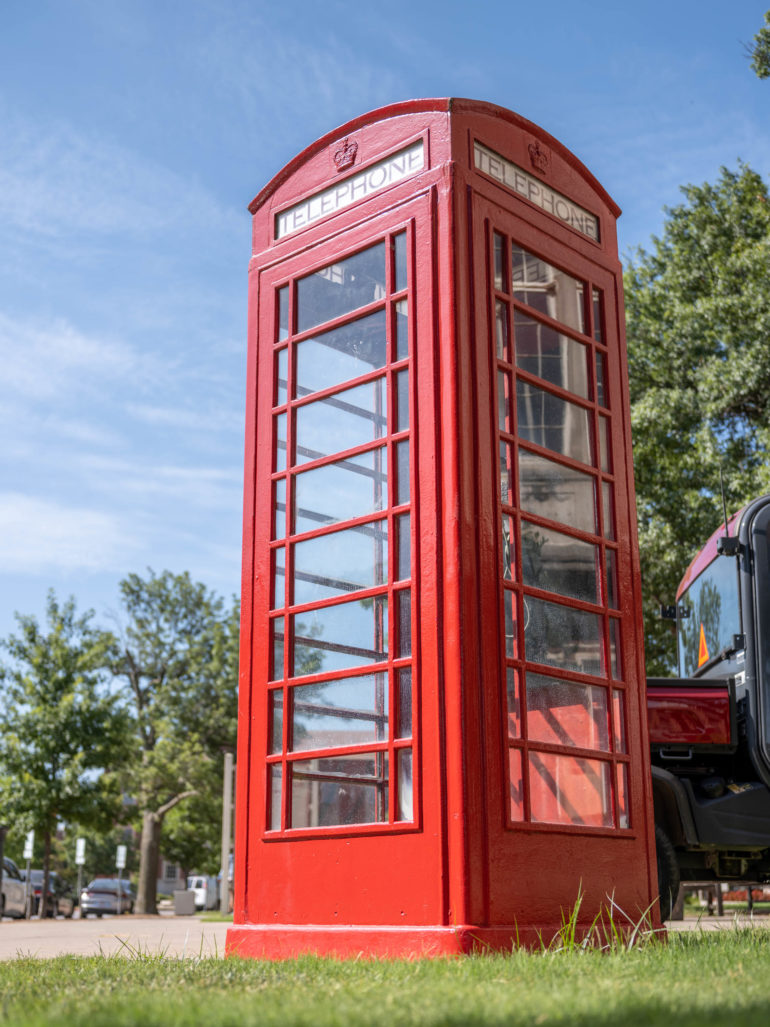
Conclusions
Likes
- The image quality is amazing
- The EVF is a joy to use
- Easy to navigate menu system
Dislikes
- The ergonomics of the camera are a mess
- Autofocus systems can be hit or miss
- Did I mention that the camera is really uncomfortable to hold?
The Fujifilm GFX 100 is no doubt a revolutionary camera. A 102 Megapixel monster that’s as easy to use as any other Mirrorless camera, and that costs under $10,000? Wow! Fujifilm has outdone themselves when it comes to the amount of technology they have packed into this camera at this price point. It’s a tragedy that not more time was spent on making the camera comfortable to hold for long periods. Can it be used handheld? Yes, of course, and you will get some awe-inspiring images. But hold it too long and you’ll pay the price for it.
This camera is great for landscape photographers, photographers who deal with commercial and fashion photography who perhaps want a little more freedom from their tripod from time to time, and for those who demand the very best image quality. For those of you who thought it might be a way to really increase your game in the wedding photography world or any other genre, you’ll be disappointed. This camera’s ergonomics are simply not designed well enough for the camera to be used off of a tripod for long periods. Fujifilm has done a great job at making a Medium Format camera that’s almost as responsive as a blazing fast Full Frame Mirrorless, but the poor ergonomics mean that this camera will be used on tripods more than it will be used handheld.

We give the Fujifilm GFX 100 four out of five stars. The camera is capable of delivering some truly stunning images, and it has made great strides in the world of Medium Format cameras. No doubt Hasselblad and Phase One are looking over their shoulders now. It’s a pity that the ergonomics and poor feeling in the hand just really don’t match up to the rest of the camera. Thanks to the Fujifilm GFX 100 though, we’re another step closer to Medium Format cameras being as versatile and as easy to use as regular Full Frame cameras, and that’s incredibly exciting. The Fujifilm GFX 100 is available from Amazon for $9,999.


